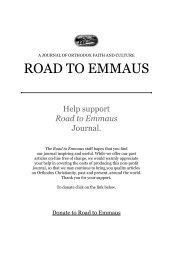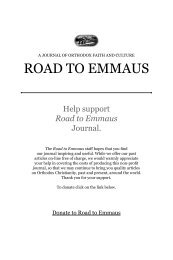RTE No 20 Interior - Road to Emmaus Journal
RTE No 20 Interior - Road to Emmaus Journal
RTE No 20 Interior - Road to Emmaus Journal
Create successful ePaper yourself
Turn your PDF publications into a flip-book with our unique Google optimized e-Paper software.
<strong>Road</strong> <strong>to</strong> <strong>Emmaus</strong> Vol. VI, <strong>No</strong>. 2 (#21)FROM JAINISM TO ORTHODOXYELESA: Yes, it is frowned upon <strong>to</strong> marry a foreigner, or someone from anothercaste. My mother’s family is more liberal, but on my father’s side you areeven expected <strong>to</strong> marry a person from the same Jain sect.SYMEON: Although western values are creeping in, I was amazed at how religionstill completely pervades the Indian culture. In the United States webelieve that we are quite religious and have the freedom <strong>to</strong> express it, but thisis much more true in India. Although the religions are intensely varied, everyonefreely expresses their belief when and where they choose. Any s<strong>to</strong>re youwalk in<strong>to</strong> will have a statue of the family deity or, if Muslim, some verses fromthe Koran. Along the street I came <strong>to</strong> a small building that I thought was afast-food kiosk. Instead, it turned out <strong>to</strong> be a little temple where passers-by goin <strong>to</strong> pay homage <strong>to</strong> the idol. Religion is a very visible part of their lives.In order <strong>to</strong> get along in our pluralistic western societies, we have privatizedour religion and it is becoming socially unacceptable <strong>to</strong> say anything about itin public. If you mention your religion, people often feel that you are proselytizing,even in academic circles. In my experience, we aren’t pluralistic, we areoutwardly almost atheistic, because we simply aren’t allowed <strong>to</strong> talk about it.ELESA: I also have <strong>to</strong> say that I’ve never come across an atheist in India. I’msure there are some, but I haven’t met one.Islamic Studies, Christian Belief<strong>RTE</strong>: Elesa, you said earlier that you went <strong>to</strong> America <strong>to</strong> study medicine.How did that change <strong>to</strong> Islamic art?ELESA: There are numerous doc<strong>to</strong>rs in my family. Every second person is adoc<strong>to</strong>r and almost every specialty was covered except neurology. I thoughtthat perhaps this was my niche, so I began my studies and did one of mybachelor’s degrees in neurophysiology.At the same time, as part of my core education, I had <strong>to</strong> take a humanitiescourse in art his<strong>to</strong>ry. My course was on Western art from 1300 <strong>to</strong> the present,and in one sense it was my first real exposure <strong>to</strong> Christianity. I hadnever read the Bible before and I was fascinated with the art, the his<strong>to</strong>ry,and the whole idea that there was a culture out there about which I knewvery little. So, I <strong>to</strong>ok a second art his<strong>to</strong>ry course, then a third, and finally acourse in Islamic art. I’d grown up around Muslims; Islamic culture wasfamiliar <strong>to</strong> me, and I immediately found that I had a connection with it thatwent beyond the beauty of Islamic art – the whole idea of these Muslimcommunities working <strong>to</strong>gether <strong>to</strong> erect mosques, medresi, and caravanserai– places for people <strong>to</strong> pray, <strong>to</strong> rest, <strong>to</strong> eat was fascinating <strong>to</strong> me. I also foundit very interesting that Islamic spirituality is expressed through architecturewithout figural imagery. As you know, Christian art (as with Hindu andJain) is almost completely figural: paintings, frescoes, icons, statues.As I was exploring art his<strong>to</strong>ry, I was also taking pre-medical courses andfound it incredibly competitive; there was a lot of back-stabbing and unhealthyreasons why people wanted <strong>to</strong> get in<strong>to</strong> medical school. I decided that I didn’twant my life <strong>to</strong> be filled with that kind of anxiety, that I’d rather do somethingdifferent, so I left pre-med <strong>to</strong> study Islamic art at a graduate level.<strong>RTE</strong>: How does that work with being Orthodox?ELESA: People have asked me before how I reconcile the two. I don’t. The onething doesn’t have anything <strong>to</strong> do with the other – one is my religion and theother is a course of study. I study Islamic theology as part of art, but it is notmy belief. Orthodoxy has immersed me in Christian culture and belief; Ihaven’t experienced Islamic spirituality. However, I am very interested inthe confluence of cultures, such as the Christian and Islamic cultures, and Irealize that many Islamic traditions came from Byzantium, from whatalready existed in the Christian world. That was their template.<strong>RTE</strong>: Weren’t many of the famous Islamic structures built by ByzantineChristian artisans?ELESA: Absolutely. The Dome of the Rock in Jerusalem is the foremostexample. The mosaics there are said <strong>to</strong> have been created by Byzantinemosaicists who were sent by the Byzantine emperor at the request of thecaliph. Also, most of the texts on Islamic art his<strong>to</strong>ry are by western authors,and some are very good, but they lack the personal experience of growing upin the culture. I’m grateful that I had Muslim neighbors and have a livingsense of their community life.<strong>RTE</strong>: You’ve grown up close <strong>to</strong>, but outside of, both Christianity and Islam,which gives you a unique vantage.3233










